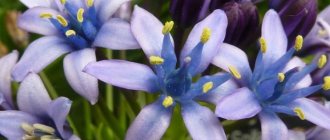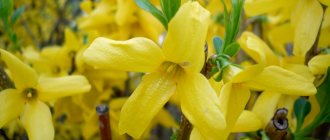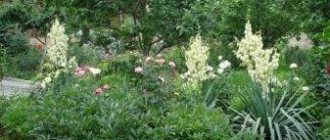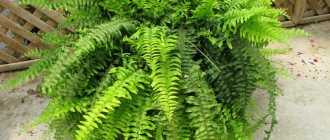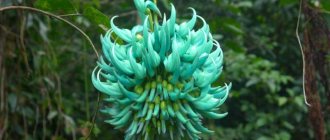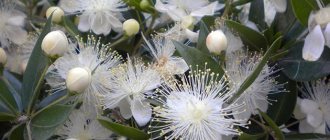- October 10, 2019
- Flowers
- Michael Michaelis
Flowers that look like bells are very popular among landscape designers. This is due not only to its decorative qualities, but also to its ease of care. In our article you will find not only a detailed description of plants with bell-shaped flowers, but also rules for caring for ornamental crops. In addition, all the information is supplemented with real photographs, so it will not be difficult for you to choose a variety that will look perfect in your yard.
Lilies of the valley - decorative and unpretentious
May lily of the valley is a herbaceous plant from the Asparagus family, which is listed in the Red Book. The culture is quite low (up to 30 centimeters in height), but has a rather beautiful appearance. Also a distinctive feature of all lilies of the valley is their thin, long, creeping rhizome with numerous shoots. At the base of the plant there are pale leaves that go well with the pale flowers.
The May lily of the valley has 6 to 20 pale yellow flowers that look very similar to bells. The largest buds are located at the base of the inflorescence, since there they receive more nutrients than those located at the top. The flowering period is from May to June. Closer to summer, rather large fruits (8 millimeters) ripen, containing from one to two large seeds.
Lily of the valley prefers to grow in regions with a temperate climate. However, if you create good conditions for it (shade and moisture), then it can be grown in the south. As for the soil, the plant prefers soil with average acidity. Air temperature can vary from 5 to 25 degrees Celsius. It is thanks to their unpretentiousness that lilies of the valley are very popular among plant lovers.
Indoor types of colors
Many different color varieties of koleria have been bred. Flowers often combine several shades and are decorated with dots and strokes. The varieties also differ in the size of the plant and bud.
The Colombian bellflower comes in standard, compact and miniature forms.
Standard varieties:
- Coleria foxglove has shoots up to 80 cm long. The leaves are light green, 15 cm long. A bell with a pink tube and a light green speckled limb.
- Koleria fusiflora is a very elegant variety with dark green leaves with red edges and reddish fibers and large orange-red flowers with yellow dots. Blooms for a long time.
- Koleria Jester is a fairly large variety. Velvety emerald foliage with a bronze touch. The petals of the burgundy tubes are decorated with dark dots.
- Koleria bogota up to 60 cm tall with green leaves. The bud is yellow-red, with purple specks inside the petal.
- Coleria pleasanta has shorter shoots - up to 40 cm, dark green fuzzy foliage and pink flowers with a crimson pattern.
Compact varieties:
- Koleriya Varshevich - 40 cm tall. The flowers have an original color - the tube is lilac with silver fibers, the lemon-colored petals and pharynx are decorated with crimson dots.
- Koleria Eriantha is a bush with green leaves decorated with a red border. Petals of scarlet fuzzy tubes with burgundy dots. The tube inside is yellow with specks.
- Koleria Linden is 30 cm high. It stands out for its spectacular foliage: dark green, pubescent. The flowers are purple with spots.
- Koleria Red is the most common species with red flowers. The petals are ruby with specks, red rays emerge from the pinkish-white throat.
Miniature colors:
- Coleria poppies with small yellow-orange bells in red spots, turning into a border. The leaves are rich green with spots.
- Koleria Ganymede is an unpretentious plant. Orange flowers with red dots on yellow edges contrast with smoky green foliage.
- Koleria Flet blooms for a long time with crimson bells with spots on light petals. Pearl-green foliage is also decorative.
Indoor varieties of koleria - photo gallery
Koleriya Varshevich is valued for its original coloring of flowers
Coleria fusiflora is characterized by velvety dark green leaves with pubescence
Koleria Bogota has an amazing bud color - yellow-red with burgundy specks
Kohleria Linden is distinguished by decorative leaves with stripes and spots
Petals with large dots look impressive against the background of the red-burgundy tubes of the Jester coloration
Koleria Ganymede - a miniature, unpretentious variety
The miniature variety Flet has a long flowering period.
Coleria Erianta has green leaves with a red border.
Kohleria red is the most common species
Koleria Maki - a miniature variety with bright orange speckled flowers
Koleria foxgloves is a large, densely pubescent plant. Koleria pleasanta has bright pink flowers with a speckled pattern.
Types of colors - video
Features of growing lilies of the valley
If you want to grow these flowers in the form of bells, then you will need to create optimal conditions for them, which have already been described just above. Further care is not difficult - you just need to make sure that the soil is always moist and the sun does not burn the delicate petals of the grass. However, even if these conditions are not met, the flower is unlikely to die, since it has fairly good resistance to drought.
However, there are still some peculiarities regarding the care of lilies of the valley. Firstly, the soil will have to be constantly fertilized with compost or rotted manure, since lilies of the valley need a large amount of microelements. The same applies to mineral fertilizers. They are worn for the first time in August, after which - at the end of the flowering period. Particular attention should be paid to the nitrogen and potassium content in the soil.
Adenophora
Adenophora is a close relative of the bell, which is easy to guess from its popular name - bell.
Review of beautiful ornamental shrubs for cottages and gardens, names with photos
Using hedgehogs to process potatoes
Types of seedling cassettes and their use
This herbaceous perennial is unpretentious, can grow in both sun and partial shade, is undemanding to the type of soil, and does not require shelter for the winter. Keep in mind that adenophora needs good soil drainage and does not grow well in acidic soils.
Bellflower blooms most of the summer. Easily propagated by seeds. In this case, winter sowing is preferable. If you did not have time to sow bells in late autumn and plan to sow in the spring, it is advisable to stratify them for a month (keep them in the refrigerator).
Foxglove - beauty and ease of care
Perennial foxglove is a herbaceous plant from the Plantain family. Translated from Latin, the name of this culture means “thimble”. The flower received this name due to the unusual shape of the corollas. However, do not forget that the genus has about 35 different varieties, which differ not only in the shades and shape of the inflorescences, but also in the characteristics of care.
In nature, you can find plants in the form of shrubs and subshrubs, the size of which ranges from 30 to 150 centimeters. A distinctive feature of this crop is its very rigid (for grass) stem with pointed tips, thanks to which the plant can withstand the weight of a huge number of bell-shaped flowers. Most varieties grown in Russia are white or pink.
Bellflower (Campanula cochleariifolia, syn. C. bellardii, C. pusilla)
It is a loose, turfy perennial from mountainous Europe.
Bellflower
Its parameters: height 8 cm, width 30 cm. Leaves are petiolate, ovate-rounded, 2 cm long. Flowers are bell-shaped, drooping, from white to lavender, blue, 1.5 cm long. Blooms in summer, very profusely.
Decorative varieties and forms:
- 'Elizabeth Oliver' - double flowers, light lavender-blue;
Bellflower 'Elizabeth Oliver'
- 'Miranda' - gray-blue flowers;
- 'White Baby' - white flowers.
Bellflower 'Miranda'.
Photo from pinterest.com. Bellflower 'White Baby'. Photo from growsonyou.com The turf of these bells is not dense.
Features of growing foxgloves
Perennial foxglove is grown exclusively from seeds, which have a fairly good germination rate. However, in order to acquire a large number of ornamental plants, you will have to prepare a substrate in advance in which they will feel comfortable. Since in nature this crop grows mainly in deciduous forests, a mixture made up of an equal amount of peat and turf soil is ideal.
It is recommended to grow seedlings in a warm room, constantly maintaining optimal soil moisture. As soon as the first shoots hatch, they can begin to be exposed to the street for several hours, carrying out the hardening procedure. 2-3 weeks after germination, the plant is planted in open ground in an area that is well lit. All that is required from the gardener in the future is to monitor the condition of the soil.
It's not just about regular moisturizing, but also about keeping away weeds. Perennial foxglove has an extremely negative attitude towards most types of pests, which suck not only moisture from the soil, but also useful microelements. Also, the substrate must be loosened from time to time so that the root system does not experience oxygen deficiency. It is also recommended to fertilize the plant once a year with organic and mineral fertilizers.
Brugmansia - exotic and large sizes
Can’t remember the name of a bell-shaped flower that looks a lot like a tree? Perhaps we are talking about Brugmansia from the nightshade family? Another name for the culture is “intoxicating tree.” It received such an unusual name due to the fact that its petals contain a strong intoxicating substance, which is used by some traditional healers for medicinal purposes.
This plant is suitable for growing in regions with mild winters, as it does not tolerate frost. However, one cannot help but note the fact that breeders are still developing new varieties that differ in their care. In addition, some varieties are even grown as houseplants. Although in this case the bush will not be able to show all its splendor without reaching a height of 150-200 centimeters.
“Angel trumpets” (as the flowers of the plant are popularly called) are distinguished by their unusual appearance, which resembles a bell enlarged several times. Their number on one plant can reach 100 pieces, which makes Brugmansia one of the best options for decorating gardens. The main drawback is that the culture is quite demanding in terms of care. In the spring and summer, you will have to shape the tree crown almost weekly.
Flowers that look like bells - names and photos (catalog)
Often all flowers with a characteristic bud shape are called indiscriminately bells. They are very delicate, beautiful and look truly spring, regardless of the flowering time. This is an invaluable element of field bouquets and country flower beds. We're talking about 25 flowers that look like bells!
Adenophora
A perennial with thick shoots and fairly large flowers, it still seems very light and airy. There are more than fifty varieties of adenophora, and almost all of them are valuable honey plants.
Lobelia
In our latitudes, low-growing branched lobelia is often grown as an annual for flower beds. It rarely grows above 20 cm and is densely dotted with blue-violet flowers.
Godetia
The colorful Godetia pollen attracts attention with its colorful buds in all shades of pink, red and purple. Blooming bells are collected in voluminous inflorescences-tassels.
Aquilegia
The herbaceous perennial is very unpretentious to external conditions, and its flowers quickly replace each other. Aquilegia has a developed root system, due to which it is hardy, but almost not suitable for transplantation.
Digitalis
An unusual plantain perennial blooms in long and voluminous clusters. But the bizarre shape of the bells in pink, orange or yellow shades is especially interesting.
Scylla
The bell-shaped scylla rarely grows above half a meter, but is densely covered with blue and purple tassels. The bells are quite small, up to 2 cm, with beautifully bent petals.
Brugmansia
The amazing Brugmansia grows so quickly that in just a day its large flower can increase by a couple of centimeters. On mature shrubs, huge bells grow up to 50 cm.
Ostrovsky
Large white bells bloom in June and are highly valued by landscape designers. Ostrovsky loves moderate humidity, neutral soil and plenty of sun.
Campanula
Another unpretentious herbaceous flower on this list is interesting for its colors. One bell is painted in several shades at once - for example, with a white center and a blue crown.
Snowdrop
In fact, the common snowdrops are called galanthus. They are ubiquitous and are especially common in lawns, forests and along rivers.
Grouse
A dozen varieties of brightly colored hazel grouse are highly valued by gardeners and landscape designers. The flowers are interestingly grouped in groups of 5 or more.
Gloxinia
The short shoots of gloxinia are densely covered with beautiful velvety leaves, which are decorative in themselves. The bells also have a slightly velvety feel and can be plain, two-tone or speckled.
Hyacinthoides
The complex name hides a beautiful and delicate early-flowering bulbous perennial. It is also called Spanish scilla or wild hyacinth.
Symphiandra
This is a rocky plant that prefers the same rocky terrain, so it is rarely found in gardens. Symphiandra is not very leafy, but in season it is covered with a scattering of large bells.
Abutilone
Abutilon flowers are more reminiscent of Chinese lanterns than bells. But this tropical plant certainly looks very elegant and interesting.
Gentian
There are dwarf varieties up to 20 cm, and there are real giants up to one and a half meters. Mostly, gentian bells are bright blue or blue, but white and yellow are also found.
Cyananthus
Another tropical guest on this list is very tiny, up to 10 cm and with a weak taproot. Tiny pale blue flowers bloom in midsummer.
Amorphophallus
It would be unfair not to mention in this list a huge exotic flower that really resembles a giant inverted bell. It is called differently in different regions - from corpse flower to snake palm.
Datura
That same dope grass is considered very dangerous and toxic. But even this does not negate the fact that she has very large and beautiful white bells with an expressive aroma.
Platycodon
The plant with wide, large bells is popularly called the wide bell. The flowers open up to 8 cm and are most often painted purple, blue or white.
Koleriya
The most interesting are the petals of Kohleria bells, painted in several colors with dots, spots and transitions. It is very low maintenance and is ideal for beginning gardeners.
Kobeya
The heat-loving kobei is not very common in our latitudes because it needs a tropical climate. But gardeners were able to adapt creeping varieties with long vine shoots and fragrant musk bells.
Smithianta
This flower stands out against the background of blue and white bells with its unusual pink color. Even the shoots have a barely noticeable burgundy tint, and the leaves are densely pubescent.
Streptocarpus
This amazing island flower resembles a double bell. This is a rosette plant with a short stem and long leaves, 2-3 flowers per peduncle.
Features of cultivation
The Brugmansia flower is highly demanding in care. For example, as mentioned earlier, he prefers regions with a temperate climate, where the air temperature is from 22 to 25 degrees. However, if this indicator is exceeded by at least 10 degrees, the plant will begin to experience severe discomfort - it will gradually begin to shed its bells, and the leaves will rapidly fade.
High-quality watering is also of great importance in care. In the summer, the tree needs quite large volumes of water. And not just any liquid will do. Most professional gardeners recommend using rain or well-settled water that does not contain harmful impurities. But in the spring you will have to irrigate the crop extremely carefully, since excess moisture will immediately lead to the development of root rot.
Brugmansia also needs regular pruning, especially if the gardener wants to form a really beautiful crown. This procedure allows not only to improve the decorative qualities of the plant, but also to speed up the onset of the flowering period. With proper care, the beauty of this tree will be simply indescribable. However, due to the fact that not every gardener can grow such a complex crop, Brugmansia is not very popular.
Conditions for keeping the colony at home
Koleria is a completely undemanding plant. It is easier to maintain than many other Gesneriaceae.
Comfortable conditions - table
| Lighting | Koleria loves light. In good light it grows compactly and blooms well. In the shade, the shoots stretch out, the leaves become smaller, and the bush falls apart. The room is shaded from the bright sun with a light curtain or mesh. The most suitable place is the western and eastern window sills. On the south side, the flower is placed away from the window. |
| Temperature | The comfortable temperature for a flower is moderate: in warm weather +20–25°C, at rest when flowering stops +15°C. |
| Humidity | Kohlerias are less demanding on humidity. But they still prefer a humid microclimate. If the apartment is very dry, humidify the air by spraying, but not the plant itself. You can increase the humidity by placing a vessel with water near the flower. |
| Watering | From spring to autumn, water moderately. In winter, watering is reduced. |
| Fertilizers | In spring and summer, feed with liquid fertilizers every week. |
| Transfer | The rapidly growing collection is transferred into large, shallow containers every spring. |
| Reproduction | Propagated by seeds, cuttings, rhizomes. |
| Crown formation | The tops of overgrown shoots are pinched for better branching and the formation of a beautiful crown. |
Good lighting promotes compact growth and lush flowering
Galanthus - snow-white splendor
Looking for white bell-shaped flowers? Then you should pay special attention to this culture, which is familiar to everyone from childhood. The snowdrop galanthus has recently become endangered because people like to pull it out along with the bulbs. However, if you buy a few seeds and start growing the crop at home, you can make your own contribution to protecting a famous crop from extinction.
Snowdrop belongs to the amaryllis family and is a perennial herb. In total, there are 18 varieties of this plant that grow in Europe and Asia. In our country, most snowdrops can be found in the Caucasus, where 16 varieties are found, most of which do not exceed 15 centimeters in height. But they all have an unusually delicate and intrusive smell.
A distinctive feature of galanthus is its high resistance to cold. This is due to the presence of unusual bulbs that are covered with dense black scales. The bulb is also covered with a special protective film, which prevents pests from damaging the planting material while the snowdrop is “sleeping.” In general, if you want to plant a crop on your site that blooms in early spring, then you won’t find a better option.
Lobelia
From June to September, lobelia pleases us with its flowering. Planting and care are not difficult. Photos taken in summer cottage gardens show that this delicate flower will look appropriate wherever you plant it. Lobelia flower fireworks have a different range of shades: white, red, burgundy, purple, blue, light blue. It is used to design flower beds, garden paths, borders, mixborders, flower “streams” or rugs.
Lobelia belongs to the bellflower family and is a creeping plant. The bushes are distinguished by abundant flowering, since small fan-shaped flowers bloom almost simultaneously, their number is huge.
The most common varieties of lobelia begin to bloom approximately 70-80 days after sowing the seeds. If you want to time the appearance of flowers just in time for the beginning of summer, then you need to start sowing seedlings in March. In general, these dates are not critical; they can be slightly shifted either towards February or closer to April. If sowing will be done at the end of February, then you will not be able to do without the help of lighting (fluorescent, halogen, LED lamps). Germination of lobelia sprouts can be observed already on the tenth or twelfth day after sowing.
Features of growing snowdrops
The snowdrop galanthus is not very popular in landscape design, but this does not mean that it will be difficult to grow it in your garden. The most important thing is to choose the optimal place for planting. It should be in the shade, but not in the cold. Despite the fact that snowdrops are winter-hardy crops, they do not tolerate strong drafts quite well, so you should not plant the plant near the corners of buildings.
Fertilizers also play a big role in caring for snowdrops. With the timely application of organic and mineral fertilizing, the gardener will be able to without much difficulty obtain a whole clearing of delicate snowdrops, which will delight all household members and guests with their appearance. But if there are not enough microelements in the soil, the crop will begin to get very sick and sooner or later die.
But snowdrops do not need frequent watering. Water should only be added during periods of lack of rainfall and drought. In this regard, most varieties of snowdrops exist separately. If you live in a region where it often rains heavily, then do not forget to regularly loosen the soil so that excess moisture evaporates from it. However, do this with extreme caution so as not to damage the bulbs in any way.
Portenschlagiana bell (Campanula portenschlagiana, syn. C. muralis)
My favorite from mountainous Croatia.
Portenschlag's bell, photo by the author
Its parameters: height up to 15 cm, width up to 50 cm. Leaves are round, 2-4 cm long. Flowers are star-shaped, bright purple, up to 2 cm long. Blooms profusely in May-June.
Portenschlag bell with mountain pine, photo by the author
It forms cushion-shaped sods. Relatively winter-hardy: winter temperature minimum -15°C. In central Russia it requires shelter. Feels great both in sunny areas and in partial shade. Loves loose, fertile, non-acidic soils; grows poorly on clay soils. Does not tolerate stagnant water. It grows very quickly, so control of the spread is required at the dacha. When planting, you should maintain a distance between plants of 10-15 cm. It reproduces well by pieces of rhizomes in the spring.
Codonopsis - diversity and sophistication
Codonopsis flower is a perennial herbaceous plant that belongs to the Campanula (bells) family. This plant is actively used by many designers for landscaping garden plots. This feature is due to the fact that the culture is not particularly special in care, and also has a huge number of different varieties, which allows you to create a truly unusual combination of different shapes and shades.
The flowers of the perennial bellflower are densely arranged, as is the foliage itself. However, to achieve an unrivaled decorative appearance, you will need to plant the plant in an area that is in the shade most of the day. Only in this case will codonopsis be able to grow up to half a meter in length. But you don’t have to worry about frost resistance, because this ornamental crop can easily withstand even the harshest climatic conditions.
Datura
Datura common (photo below) is difficult to confuse with other plants. He is big, even huge. The bush can grow up to a meter in height. The leaves are beautifully cut. They look powerful, fresh, attractive (for those who eat grass). Only animals will not feast on them. They are repelled by a strange, even disgusting smell. Datura plant can be found in large quantities in any area. Typically, Datura chooses the following areas for its habitat: wastelands, roadsides and vegetable gardens. Datura grass flowers are so magnificent that this plant has attracted the attention of landscape designers. It can be seen in flower beds and lawns. The plant is used as an ornamental. Moreover, it has a fairly long flowering period: almost all summer (depending on climatic conditions) it delights viewers with huge bowls of white flowers. You just need to keep in mind that the plant is poisonous. Flowers can be intoxicating (hence the name) with just their scent. In hot weather, in the absence of wind, it concentrates around the plant. It is not advisable to plant such “decor” in the area near children’s playgrounds, institutions, cafes, and so on. Kids may not realize that they should run away from a cloying aroma. The result is a hospital.
Features of growing codonopsis
Caring for codonopsis is not difficult, so even an inexperienced gardener can grow the crop. The most important thing is to maintain a decorative appearance through constant trimming. In addition, if you want to achieve truly beautiful flowering, then regularly add organic and mineral fertilizers to the soil. This is especially true for the period when the plant begins to form its large buds.
One of the main features of the culture is that despite its fragile appearance, it has very strong immunity and is resistant to most types of diseases. Although this does not mean that you should neglect the basic rules for caring for the plant. For example, if a gardener ignores the fact that there is not enough moisture in the soil, then sooner or later the beautiful green leaves will simply begin to fade and the buds will fall off.
It is recommended to grow codonopsis from seeds. However, be prepared for the fact that it will be possible to achieve flowering no earlier than in the third year of life. In addition, for successful rooting and development of a young plant, you will need to use a substrate that has a rather loose structure. As for the composition of the soil itself, it should be quite acidic. The recommended acidity level is 3.5 pH units.
Gargan bell (Campanula garganica, syn. C. elatines var. garganica)
Creeping rhizomatous perennial from Southern Europe.
Campanula garganica
Its parameters: height 5 cm, width up to 30 cm. Leaves up to 3.5 cm long from kidney-shaped to oval-heart-shaped. The flowers are star-shaped, bright blue, up to 2 cm in diameter, in racemes. Blooms profusely in summer.
Decorative varieties:
- 'Dickson's Gold', f. aurea - yellow leaves, blue flowers;
Bellflower 'Dickson's Gold', appearance. Photo from growsonyou.com. Close-up of its flowers. Photo from edrom-nurseries.co.uk
- 'WH Paine' has lavender-blue flowers with a white center.
Bellflower 'WH Paine', appearance.
Photo from alpinegardensociety.net. This is a closer portrait. Photo from bellflowernursery.co.uk They all form low, cushion-shaped tufts.

